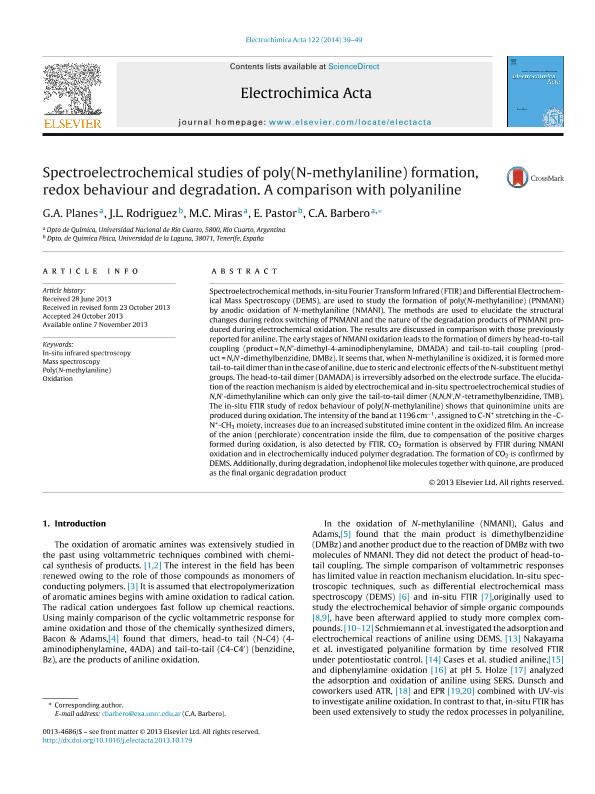Artículo
Spectroelectrochemical studies of poly(N-methylaniline) formation, redox behaviour and degradation. A comparison with polyaniline
Planes, Gabriel Angel ; Rodriguez, Jose Luis; Miras, Maria Cristina; Tejera, Elena Pastor; Barbero, César Alfredo
; Rodriguez, Jose Luis; Miras, Maria Cristina; Tejera, Elena Pastor; Barbero, César Alfredo
 ; Rodriguez, Jose Luis; Miras, Maria Cristina; Tejera, Elena Pastor; Barbero, César Alfredo
; Rodriguez, Jose Luis; Miras, Maria Cristina; Tejera, Elena Pastor; Barbero, César Alfredo
Fecha de publicación:
03/2014
Editorial:
Pergamon-Elsevier Science Ltd.
Revista:
Electrochimica Acta
ISSN:
0013-4686
Idioma:
Inglés
Tipo de recurso:
Artículo publicado
Clasificación temática:
Resumen
Spectroelectrochemical methods, in-situ Fourier Transform Infrared (FTIR) and Differential Electrochemical Mass Spectroscopy (DEMS), are used to study the formation of poly(N-methylaniline) (PNMANI) by anodic oxidation of N-methylaniline (NMANI). The methods are used to elucidate the structural changes during redox switching of PNMANI and the nature of the degradation products of PNMANI produced during electrochemical oxidation. The results are discussed in comparison with those previously reported for aniline. The early stages of NMANI oxidation leads to the formation of dimers by head-to-tail coupling (product = N,N’-dimethyl-4-aminodiphenylamine, DMADA) and tail-to-tail coupling (product = N,Ń-dimethylbenzidine, DMBz). It seems that, when N-methylaniline is oxidized, it is formed more tail-to-tail dimer than in the case of aniline, due to steric and electronic effects of the N-substituent methyl groups. The head-to-tail dimer (DAMADA) is irreversibly adsorbed on the electrode surface. The elucidation of the reaction mechanism is aided by electrochemical and in-situ spectroelectrochemical studies of N,Ń-dimethylaniline which can only give the tail-to-tail dimer (N,N,Ń,Ń-tetramethylbenzidine, TMB). The in-situ FTIR study of redox behaviour of poly(N-methylaniline) shows that quinonimine units are produced during oxidation. The intensity of the band at 1196 cm−1, assigned to C-N+ stretching in the -C-N+-CH3 moiety, increases due to an increased substituted imine content in the oxidized film. An increase of the anion (perchlorate) concentration inside the film, due to compensation of the positive charges formed during oxidation, is also detected by FTIR. CO2 formation is observed by FTIR during NMANI oxidation and in electrochemically induced polymer degradation. The formation of CO2 is confirmed by DEMS. Additionally, during degradation, indophenol like molecules together with quinone, are produced as the final organic degradation product
Archivos asociados
Licencia
Identificadores
Colecciones
Articulos(CCT - CORDOBA)
Articulos de CTRO.CIENTIFICO TECNOL.CONICET - CORDOBA
Articulos de CTRO.CIENTIFICO TECNOL.CONICET - CORDOBA
Citación
Barbero, César Alfredo; Tejera, Elena Pastor; Planes, Gabriel Angel; Rodriguez, Jose Luis; Miras, Maria Cristina; Spectroelectrochemical studies of poly(N-methylaniline) formation, redox behaviour and degradation. A comparison with polyaniline; Pergamon-Elsevier Science Ltd.; Electrochimica Acta; 122; 3-2014; 39-49
Compartir
Altmétricas



